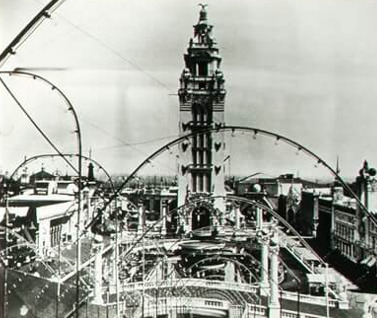
By Jim O’Neal
Typical stories about Coney Island usually start with some version of huddled masses arriving on America’s Eastern shore at the turn of the century and, before seeing the Statue of Liberty, the Brooklyn Bridge or the newborn skyscrapers, encountering a welcome beacon of bright wonders spread along the sands of the southern tip of Brooklyn. It is a dramatic way to introduce that star of light called the “City of Fire” and some even take it to the next level by comparing it to the bush Moses encountered on Mount Horeb … which burned, but was not consumed.
That does put Coney Island in a revered historical context, but in reality, it is wrong.
From 1885 to 1896, the Elephantine Colossus, a seven-story building (that included a brothel) shaped like an elephant, was actually the first thing immigrants saw when arriving in New York. Designed by James Lafferty – who died broke in 1898 – the 31-room building served as a hotel, concert hall and amusement bazaar. It was built two years before the Statue of Liberty at an estimated cost of $250,000.
It was the second of three elephant buildings built by Lafferty, and on May 30, 1885, The New York Times reported on its opening: “C.A. Brandenburg, manager, hosted a dinner, followed by a tour to the top where he pointed out ‘the spray from Niagara Falls, the Mississippi River, a clump of trees in Yellowstone Park, Rio Janeiro [sic], the Bay of Biscay and even the steeples of London and Paris – remarkable, and all for 10 cents!”
This was Coney Island, three great amusement parks – Steeplechase, Luna Park and Dreamland – each outlined and adorned with yet another fresh and wondrous sight: the electric light bulb. When the sun went down, what appeared to those prospective new Americans was the whole island, strung with frozen pearls of fire, spinning and plunging and whirling. Coney Island, even in daylight, was a stunning experience.
By 1910, just inside Luna Park’s main gate were two crosses plunged into a red heart in some transported bit of Catholic iconography; pilgrims entered a fairy-tale ramble of minarets and onion domes, turrets and colonnades, lagoons and trellises. It was Frederick Thompson’s architectural jungle: grossly extravagant amusement created for the hell of it. The moody alcoholic designed many of Coney Island’s rides like the Steeplechase Ride – a relatively minor jaunt on mechanical horses, until suddenly challenged by an obstacle course that included a dwarf in a harlequin suit taking a swing at legs with a cattle prod. Crowds of New Yorkers in bleachers got a big laugh out of it.
Still other exhibitions reflected the era’s less politically correct sense of entertainment, like revelers watching actual premature babies struggling for life in a sideshow that featured the country’s first incubator. You could visit a year-round village filled with dwarfs and midgets, and view African tribesmen living in actual grass huts. Even the furies of the latest global disasters were introduced on huge stages – hurricanes, floods, volcanic eruptions and war. All products of a time when Americans liked their entertainment tinged with a taste of danger.
Coney was more than a Sunday outing. It was a place where immigrants were literally assimilated in the roiling holiday mobs, a place where they could watch the pageant of their lives displayed like a movie. A conductor-driven rollercoaster called the “Rough Rider” once went ripping through the retaining wall, killing three passengers. It was up and running again the same day. To its wide-eyed audiences, Coney Island was close to real life. Was it any wonder one of the most popular attractions was a fake tenement building that was set on fire and the fire put out by fake firemen – every day, day after day – for a viewing public that itself lived in fire-trap tenements and lived in constant fear?
Coney Island finally played with fire too long, with Dreamland burning in 1911 and Luna Park closing after a fire in 1946. Steeplechase closed in 1964. But the Coney spirit lived on, imitated by the World’s Fairs in Chicago (1933) and New York (1939-40 and 1964-65), and in names of deteriorating amusement parks on the outskirts of many cities. None, though, can hold a candle to that frozen fire that once burned so brightly along the sands of Long Island.
We are left with car chases, oil spills and hurricanes on CNN.
 Intelligent Collector blogger JIM O’NEAL is an avid collector and history buff. He is president and CEO of Frito-Lay International [retired] and earlier served as chair and CEO of PepsiCo Restaurants International [KFC Pizza Hut and Taco Bell].
Intelligent Collector blogger JIM O’NEAL is an avid collector and history buff. He is president and CEO of Frito-Lay International [retired] and earlier served as chair and CEO of PepsiCo Restaurants International [KFC Pizza Hut and Taco Bell].
